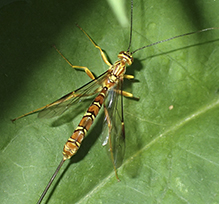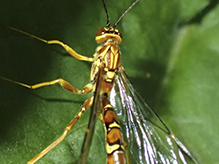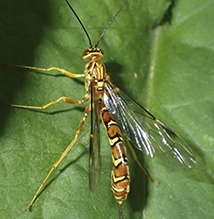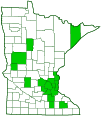Greene’s giant ichneumonid wasp
(Megarhyssa greenei)
Conservation • Description • Habitat • Ecology • Distribution • Taxonomy
Conservation Status |
|
|||||||
| IUCN Red List | not listed |
|||||||
| NatureServe | NNR - Unranked |
|||||||
| Minnesota | not listed |
|||||||
Description |
||
Greene’s giant ichneumonid wasp is a common, large, parasitic wasp. Its large size and bright coloration make it one of the “charismatic megafaunas” of the insect world. It occurs in the United States and southern Canada mostly east of the Great Plains, though some have been found as far west as Wyoming. It is found in deciduous forests and woodlands. The larvae prey on the larvae of pigeon tremex in dead and decaying hardwood trees. Adults are seen from June through September. They do not feed. Adults are large, slender, and long-legged. The body is reddish-brown and yellow. Size is sometimes given in terms of forewing length. On the female the forewing length is ½″ to 1 1⁄16″ (12 to 27 mm). On the male it is ⅜″ to ⅝″ (10 to 16 mm). The head is rounded-triangular and mostly yellow. There are two large compound eyes on the sides of the head and three small simple eyes (ocelli) in a triangle near the top of the head. A narrow dark band runs between the compound eyes and through the ocelli. The antennae are thread-like, have at least 16 segments, and are straight, not elbowed. The plate over the upper lip (clypeus) is small, squarish, and flattened. The face and clypeus form a smooth convex surface with no groove. There is a reddish-brown spot on the face just above the clypeus, but the face is otherwise entirely yellow. There are no vertical black stripes. The jaws (mandibles) are short and stout. The front part of the body (mesosoma) is reddish-brown and yellow and has three segments. The upper plate on the first segment (pronotum) is more or less triangular and extends nearly to the small plates (tegulae) covering the wing bases. There are breathing pores (spiracles) running the entire length of the thorax. The rear part of the body (metasoma) is long, cylindrical in front becoming flattened in the rear. Segments 2 and 3 are separate, not fused together, with a pair of spiracles on each segment. Segments 2 through 5 are hardened and rigid. On the female, the metasoma is reddish-brown and has a yellow band bordered by black at the rear margin of each segment (tergite). On tergite 3 and the following tergites the band is interrupted in the middle. On tergites 3, through 5, the band continues forward on the lateral margin, effectively creating a pair of L-shaped spots. Tergites 8 and 9 are elongated, the tip is modified as a horn, and a long needle-like tube (ovipositor) projects from the tip. The ovipositor sheath is dark brown and about 1.8 times as long as the forewing. Tergites 2 through 6 each have a pair of raised projections (tubercles) close to the front lower (sternal) margin. These act as guides for the ovipositor when drilling into wood. Within the expanded tip of the abdomen there is an expandable membrane that helps the female extract her ovipositor from the wood. When deployed it is white, translucent, and circular. On the male the metasoma is reddish-brown with yellow and black markings on just the first two or three tergites. The wings are long, narrow, clear, and lightly tinged smoky brown. On the forewing the costal and radial veins are fused so that there is no costal cell. The base of the cubital (cu) vein is lacking. There are two recurrent (backward-turning) veins forming a cell. The first submarginal cell and the first discoidal cell are fused into a single large discosubmarginal cell. The shape of the discosubmarginal cell is said to resemble a horse’s head and is sometimes called the “horsehead cell.” The small second submarginal cell (areolet) near the center of the wing is triangular and is connected to the Rs vein by a short cross vein (petiolate). On the hindwing, the radial sector-medial cross (rs-m) vein joins the radial sector (Rs) vein after the split between the Rs and R1 veins. The sub-basal cell is closed. On the female there is usually a large brown patch at the base of cell 2r1. On the male there is no dark patch. |
||
Size |
||
Female forewing length: ½″ to 1 1⁄16″ (12 to 27 mm) Male forewing length: ⅜″ to ⅝″ (10 to 16 mm) |
||
Similar Species |
||
Long-tailed giant ichneumonid wasp (Megarhyssa macrurus) has two vertical black stripes on the face. On the female the ovipositor sheath is about 3.0 times as long as the forewing. On the male there is a brown patch at the base of cell 2r1. On the female forewing there 2 or 3 dark patches, including a dark brown patch on the front half and sometimes a dark patch at the tip. |
||
Habitat |
||
Deciduous forests and woodlands |
||
Ecology |
||
Season |
||
One generation per year: June through September |
||
Behavior |
||
It takes about an hour for the female to drill into wood, deposit an egg, and extract her ovipositor. During this time she is vulnerable to predation and is easily photographed. |
||
Life Cycle |
||
The female locates a pigeon tremex grub by tapping the bark with her antennae. When located, she drills her ovipositor into the wood and deposits a single egg on or near the grub. When the egg hatches the larva consumes the grub. It pupates in the burrow and the adult emerges in the spring. Males emerge first. They locate females by the sound of the female larva chewing an escape tube into the wood. They usually inseminate the female before she emerges. |
||
Larva Food |
||
Pigeon tremex larvae |
||
Adult Food |
||
Adults do not feed |
||
Distribution |
||||
|
Sources |
|||
| 6/28/2023 | ||||
Occurrence |
||||
|
||||
Taxonomy |
|||
Order |
Hymenoptera (Ants, Bees, Wasps, and Sawflies) | ||
Suborder |
Apocrita (Narrow-waisted Wasps, Ants, and Bees) | ||
Superfamily |
Ichneumonoidea (Ichneumonid and Braconid Wasps) | ||
Family |
Ichneumonidae (Ichneumonid Wasps) | ||
Subfamily |
Rhyssinae | ||
Genus |
Megarhyssa (giant ichneumonid wasps) | ||
Synonyms |
|||
|
|||
Common Names |
|||
Greene’s giant ichneumonid wasp |
|||
Glossary
Clypeus
On insects, a hardened plate on the face above the upper lip (labrum).
Mesosoma
In Hymenoptera: the front part of the body, consisting of all three segments of the thorax and the first segment of the abdomen, to which the wings are attached.
Metasoma
In Hymenoptera: the armored rear part of the body, consisting of the second segment of the abdomen and all segments posterior to it.
Ocellus
Simple eye; an eye with a single lens. Plural: ocelli.
Ovipositor
A tube-like organ near the end of the abdomen of many female insects, used to prepare a place for an egg and to place the egg.
Pronotum
The exoskeletal plate on the upper side of the first segment of the thorax of an insect.
Spiracle
A small opening on the surface of an insect or arachnid through which it breathes.
Tegula
A small, hardened, plate, scale, or flap-like structure that overlaps the base of the forewing of insects in the orders Lepidoptera, Hymenoptera, Diptera, and Homoptera. Plural: tegulae.
Tergite
The upper (dorsal), hardened plate on a segment of the thorax or abdomen of an arthropod or myriapod.
Tibia
The fourth segment of an insect leg, after the femur and before the tarsus (foot). The fifth segment of a spider leg or palp. Plural: tibiae.
Tubercle
On plants and animals: a small, rounded, raised projection on the surface. On insects and spiders: a low, small, usually rounded, knob-like projection. On slugs: raised areas of skin between grooves covering the body.
Visitor Photos |
|||||
Share your photo of this insect. |
|||||
| This button not working for you? Simply email us at info@MinnesotaSeasons.com. Attach one or more photos and, if you like, a caption. |
|||||
Roger R. |
|||||
 |
|||||
Babette Kis |
|||||
Megarhyssa greenei - Greene's Giant Ichneumonid Wasp Greene's Giant Ichneumonid Wasp, Barnes Prairie hedgerow, Racine Co., WI. Photos taken June 19, 2021. In Wisconsin, I usually see these ichneumonids at hedgerows, between the tallgrass prairie remnants. They're impressive in size and color pattern. |
 |
||||
 |
 |
||||
MinnesotaSeasons.com Photos |
|||||
|
|||||

Slideshows |
||

Visitor Videos |
|||
Share your video of this insect. |
|||
| This button not working for you? Simply email us at info@MinnesotaSeasons.com. Attach a video, a YouTube link, or a cloud storage link. |
|||
Other Videos |
|||
| Megarhyssa greenei (scorpion wasp) Don D'Angelo |
|||
About
Aug 3, 2016 |
|||


Created: 6/28/2023
Last Updated:

